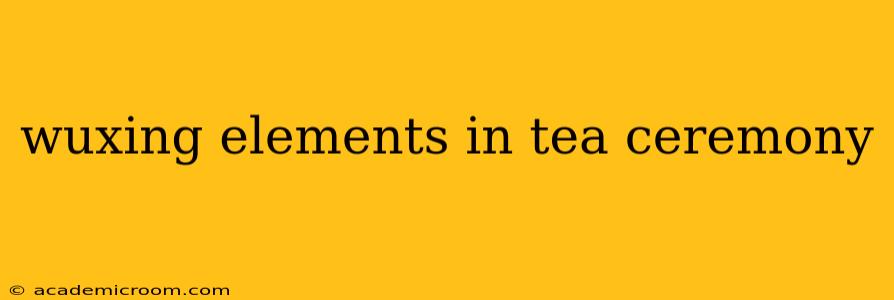The Chinese tea ceremony, or Cha Dao (茶道), is far more than just the preparation and consumption of tea. It's a deeply symbolic practice rooted in philosophy, aesthetics, and the harmonious balance of the five elements, or Wu Xing (五行): Wood, Fire, Earth, Metal, and Water. Understanding the Wu Xing's influence reveals a deeper appreciation for the ceremony's richness and intentionality. This exploration delves into the subtle yet powerful presence of these elements throughout the ritual.
What are the Five Elements (Wu Xing)?
Before diving into their manifestation in the tea ceremony, let's briefly revisit the core principles of Wu Xing. These aren't merely physical elements; they represent cyclical processes, energies, and phases of change. Each element interacts with the others in a complex interplay of creation (sheng 生) and destruction (ke 克). This dynamic balance is crucial to understanding the underlying philosophy of the tea ceremony.
- Wood (木): Represents growth, spring, vitality, and upward movement.
- Fire (火): Represents passion, summer, transformation, and illumination.
- Earth (土): Represents stability, late summer, nurturing, and grounding.
- Metal (金): Represents clarity, autumn, harvest, and introspection.
- Water (水): Represents stillness, winter, wisdom, and flow.
How are the Wu Xing Elements Represented in the Tea Ceremony?
The Wu Xing elements aren't explicitly displayed, but their influence permeates every aspect of the ceremony, from the selection of teaware to the spatial arrangement and the overall atmosphere.
1. The Teaware and its Material (Metal, Earth, Water)
The materials used in the tea ceremony often reflect the Wu Xing. A clay teapot (Earth) grounded and nurturing, a silver tea caddy (Metal) represents clarity and refinement, while a porcelain teacup (Earth, occasionally incorporating water-based glazes) offers elegance and purity. The choice of material subtly influences the energy of the experience.
2. The Tea Itself (Wood, Earth, Water)
The type of tea chosen can also reflect the elements. The cultivation of tea plants (Wood) requires nurturing earth and water. Green teas, with their vibrant freshness, often evoke Wood, while oolong teas, with their earthier notes, resonate with Earth. The preparation process, involving water, further emphasizes the element's importance.
3. The Preparation Process (Fire, Water)
The boiling of water (Water transformed by Fire) is a crucial step, symbolizing the transformation of potential energy. The controlled heat (Fire) used during brewing actively participates in extracting the tea's essence and flavors, reflecting the transformative power of Fire. The careful pouring of the tea reflects the flow and gentle nature of Water.
4. The Setting and Atmosphere (All Five Elements)
The setting of the tea ceremony contributes significantly. A serene garden (Wood) provides a calming backdrop, while the warmth of the tea room (Fire) encourages connection. The carefully arranged objects (Earth) on the table, such as incense burners and tea caddies, create a sense of balance and stability. The careful arrangement and choice of décor can also subtly incorporate all five elements.
5. The Movement and Flow (Water, Wood)
The graceful movements of the tea master, flowing like Water, are a vital aspect of the ceremony. Each gesture, from preparing the tea to serving it, is deliberate, reflecting the cyclical nature of Wu Xing. The mindful preparation emphasizes intentionality and presence, resonating with the growth and vitality represented by Wood.
Frequently Asked Questions
How does the Wu Xing philosophy influence the taste of the tea?
While the Wu Xing doesn't directly impact the chemical composition of tea, the principles of balance and harmony influence the choice of tea and its preparation. This mindful approach enhances the overall sensory experience, making the tea taste more refined and appreciated. The subtle energies associated with each element can be sensed through tasting and mindful reflection on the experience.
What are some practical examples of Wu Xing in a tea ceremony?
Choosing a Yixing teapot (earthenware, Earth element) to brew a pu-erh tea (earthy and rich, associating with Earth), served in delicate porcelain cups (Earth element, possibly with a water-based glaze), within a garden setting (Wood element), with the heat of the brewing process (Fire element) creating steam and transforming the water (Water element) into the perfect cup of tea. The meditative act of preparing and consuming the tea itself embodies the overall harmony of Wu Xing.
Can anyone participate in a tea ceremony emphasizing the Wu Xing elements?
Absolutely! While a deep understanding of the Wu Xing philosophy adds layers of meaning, the beauty of the tea ceremony lies in its adaptability. Anyone can appreciate the serenity and ritualistic aspect regardless of their philosophical background. Focusing on the intentionality, mindful preparation, and mindful drinking all contribute to a harmonious experience regardless of specific elemental awareness.
By understanding the subtle interplay of Wu Xing in the tea ceremony, one gains a deeper appreciation for its depth, beauty, and profound connection to nature and inner harmony. It's a journey of balance, mindfulness, and the pursuit of perfection in simplicity.
